lock JEEP WRANGLER 2012 JK / 3.G Owner's Manual
[x] Cancel search | Manufacturer: JEEP, Model Year: 2012, Model line: WRANGLER, Model: JEEP WRANGLER 2012 JK / 3.GPages: 124, PDF Size: 5.48 MB
Page 90 of 124
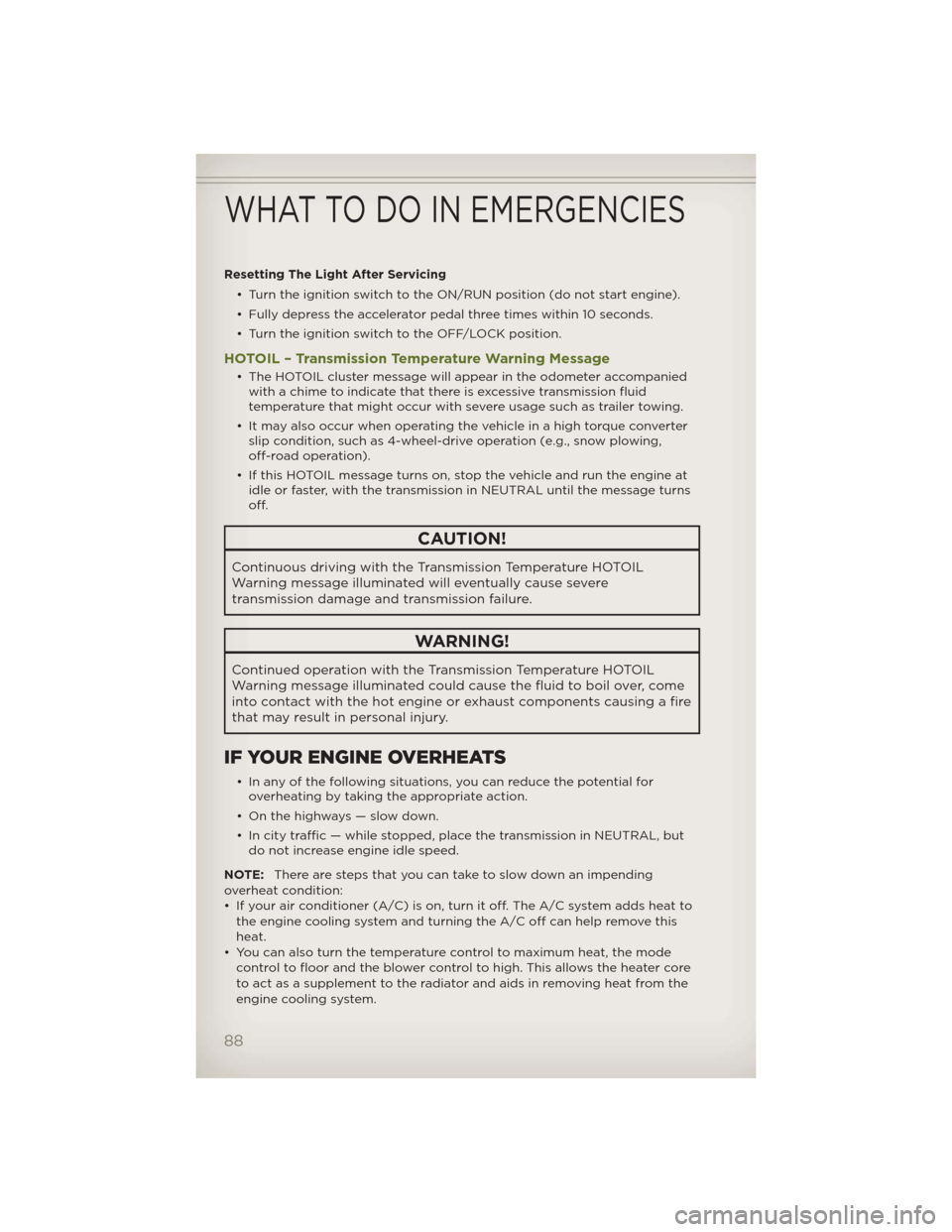
Resetting The Light After Servicing
• Turn the ignition switch to the ON/RUN position (do not start engine).
• Fully depress the accelerator pedal three times within 10 seconds.
• Turn the ignition switch to the OFF/LOCK position.
HOTOIL – Transmission Temperature Warning Message
• The HOTOIL cluster message will appear in the odometer accompanied
with a chime to indicate that there is excessive transmission fluid
temperature that might occur with severe usage such as trailer towing.
• It may also occur when operating the vehicle in a high torque converter
slip condition, such as 4-wheel-drive operation (e.g., snow plowing,
off-road operation).
• If this HOTOIL message turns on, stop the vehicle and run the engine at
idle or faster, with the transmission in NEUTRAL until the message turns
off.
CAUTION!
Continuous driving with the Transmission Temperature HOTOIL
Warning message illuminated will eventually cause severe
transmission damage and transmission failure.
WARNING!
Continued operation with the Transmission Temperature HOTOIL
Warning message illuminated could cause the fluid to boil over, come
into contact with the hot engine or exhaust components causing a fire
that may result in personal injury.
IF YOUR ENGINE OVERHEATS
• In any of the following situations, you can reduce the potential for
overheating by taking the appropriate action.
• On the highways — slow down.
• In city traffic — while stopped, place the transmission in NEUTRAL, but
do not increase engine idle speed.
NOTE:There are steps that you can take to slow down an impending
overheat condition:
• If your air conditioner (A/C) is on, turn it off. The A/C system adds heat to
the engine cooling system and turning the A/C off can help remove this
heat.
• You can also turn the temperature control to maximum heat, the mode
control to floor and the blower control to high. This allows the heater core
to act as a supplement to the radiator and aids in removing heat from the
engine cooling system.
WHAT TO DO IN EMERGENCIES
88
Page 91 of 124
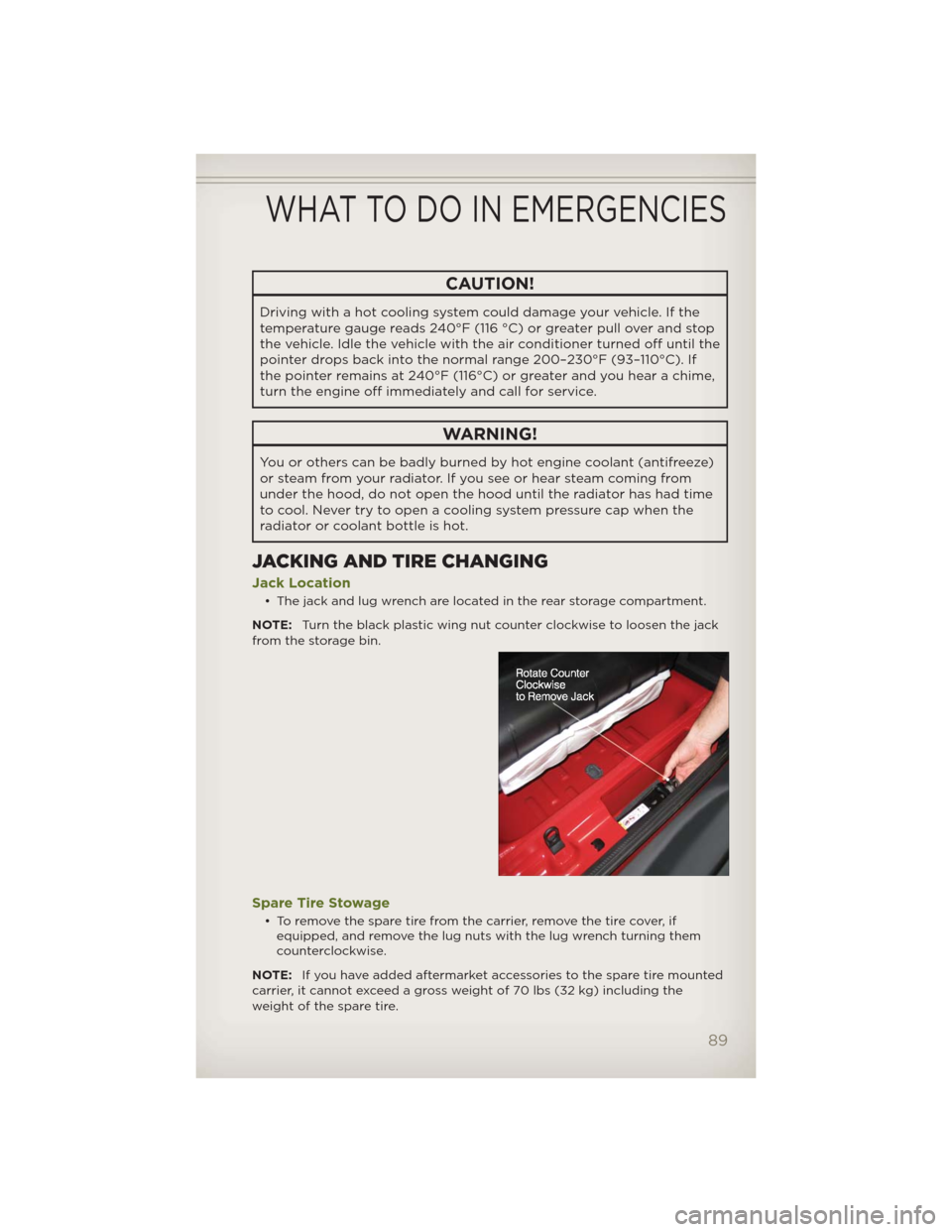
CAUTION!
Driving with a hot cooling system could damage your vehicle. If the
temperature gauge reads 240°F (116 °C) or greater pull over and stop
the vehicle. Idle the vehicle with the air conditioner turned off until the
pointer drops back into the normal range 200–230°F (93–110°C). If
the pointer remains at 240°F (116°C) or greater and you hear a chime,
turn the engine off immediately and call for service.
WARNING!
You or others can be badly burned by hot engine coolant (antifreeze)
or steam from your radiator. If you see or hear steam coming from
under the hood, do not open the hood until the radiator has had time
to cool. Never try to open a cooling system pressure cap when the
radiator or coolant bottle is hot.
JACKING AND TIRE CHANGING
Jack Location
• The jack and lug wrench are located in the rear storage compartment.
NOTE:Turn the black plastic wing nut counter clockwise to loosen the jack
from the storage bin.
Spare Tire Stowage
• To remove the spare tire from the carrier, remove the tire cover, if
equipped, and remove the lug nuts with the lug wrench turning them
counterclockwise.
NOTE:If you have added aftermarket accessories to the spare tire mounted
carrier, it cannot exceed a gross weight of 70 lbs (32 kg) including the
weight of the spare tire.
WHAT TO DO IN EMERGENCIES
89
Page 92 of 124
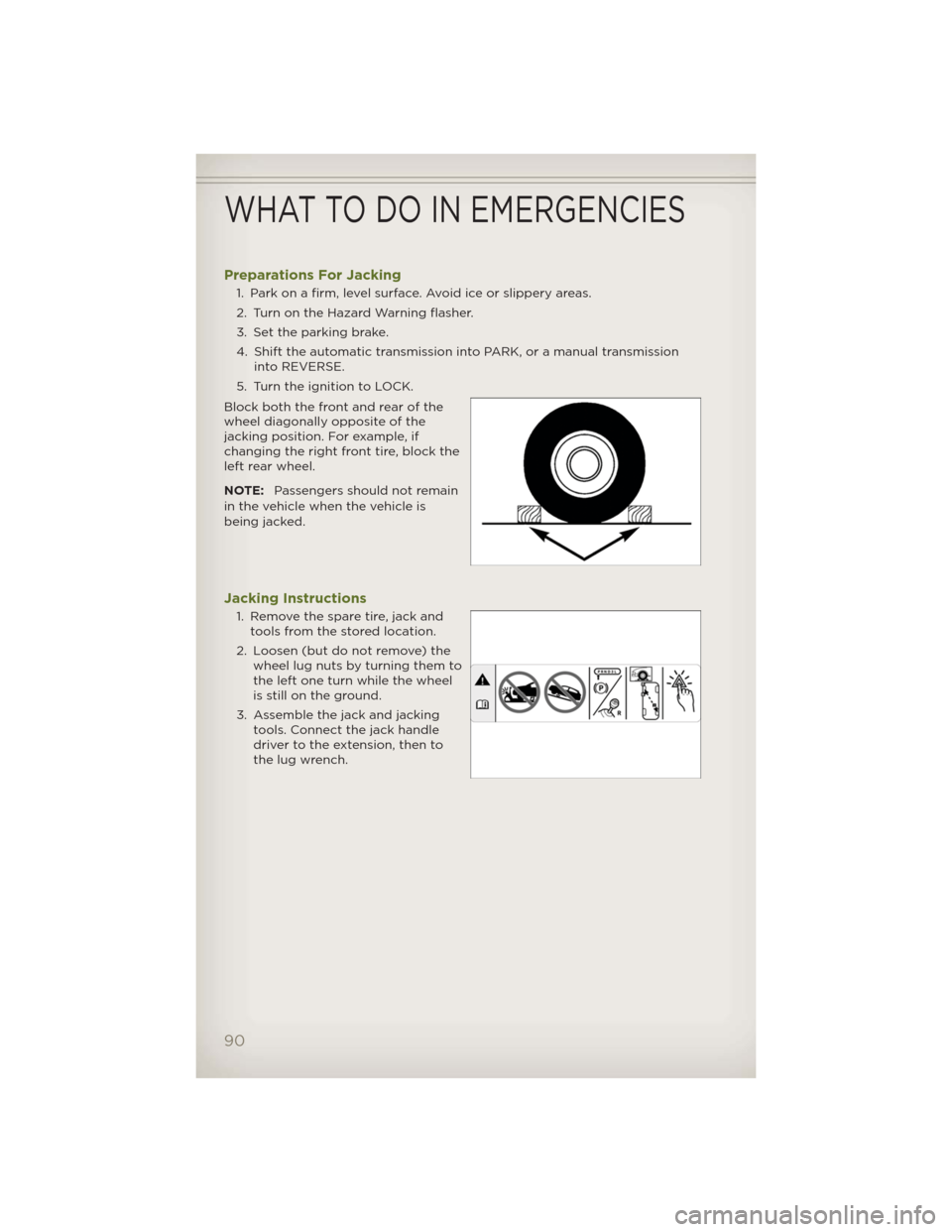
Preparations For Jacking
1. Park on a firm, level surface. Avoid ice or slippery areas.
2. Turn on the Hazard Warning flasher.
3. Set the parking brake.
4. Shift the automatic transmission into PARK, or a manual transmission
into REVERSE.
5. Turn the ignition to LOCK.
Block both the front and rear of the
wheel diagonally opposite of the
jacking position. For example, if
changing the right front tire, block the
left rear wheel.
NOTE:Passengers should not remain
in the vehicle when the vehicle is
being jacked.
Jacking Instructions
1. Remove the spare tire, jack and
tools from the stored location.
2. Loosen (but do not remove) the
wheel lug nuts by turning them to
the left one turn while the wheel
is still on the ground.
3. Assemble the jack and jacking
tools. Connect the jack handle
driver to the extension, then to
the lug wrench.
WHAT TO DO IN EMERGENCIES
90
Page 93 of 124
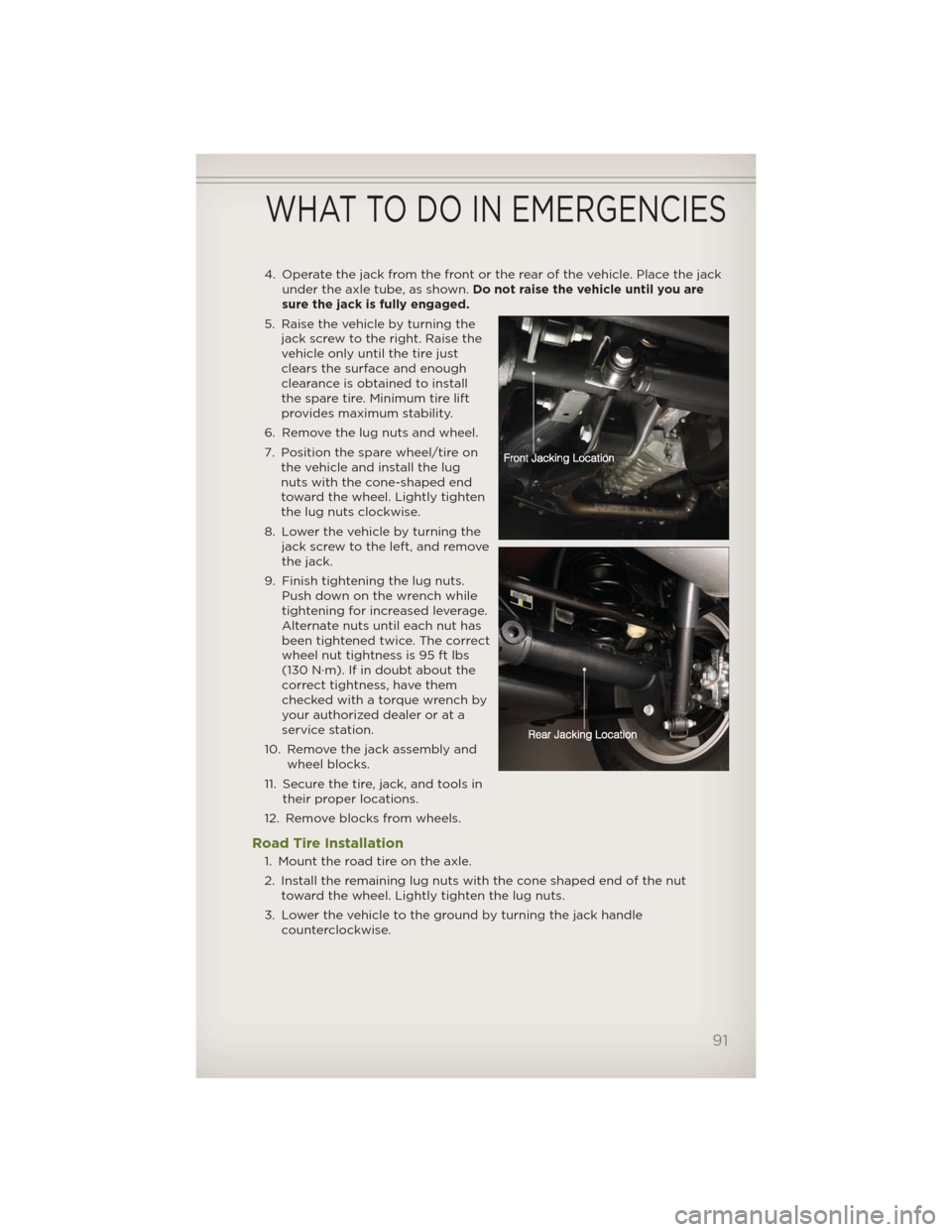
4. Operate the jack from the front or the rear of the vehicle. Place the jack
under the axle tube, as shown.Do not raise the vehicle until you are
sure the jack is fully engaged.
5. Raise the vehicle by turning the
jack screw to the right. Raise the
vehicle only until the tire just
clears the surface and enough
clearance is obtained to install
the spare tire. Minimum tire lift
provides maximum stability.
6. Remove the lug nuts and wheel.
7. Position the spare wheel/tire on
the vehicle and install the lug
nuts with the cone-shaped end
toward the wheel. Lightly tighten
the lug nuts clockwise.
8. Lower the vehicle by turning the
jack screw to the left, and remove
the jack.
9. Finish tightening the lug nuts.
Push down on the wrench while
tightening for increased leverage.
Alternate nuts until each nut has
been tightened twice. The correct
wheel nut tightness is 95 ft lbs
(130 N·m). If in doubt about the
correct tightness, have them
checked with a torque wrench by
your authorized dealer or at a
service station.
10. Remove the jack assembly and
wheel blocks.
11. Secure the tire, jack, and tools in
their proper locations.
12. Remove blocks from wheels.
Road Tire Installation
1. Mount the road tire on the axle.
2. Install the remaining lug nuts with the cone shaped end of the nut
toward the wheel. Lightly tighten the lug nuts.
3. Lower the vehicle to the ground by turning the jack handle
counterclockwise.
WHAT TO DO IN EMERGENCIES
91
Page 94 of 124
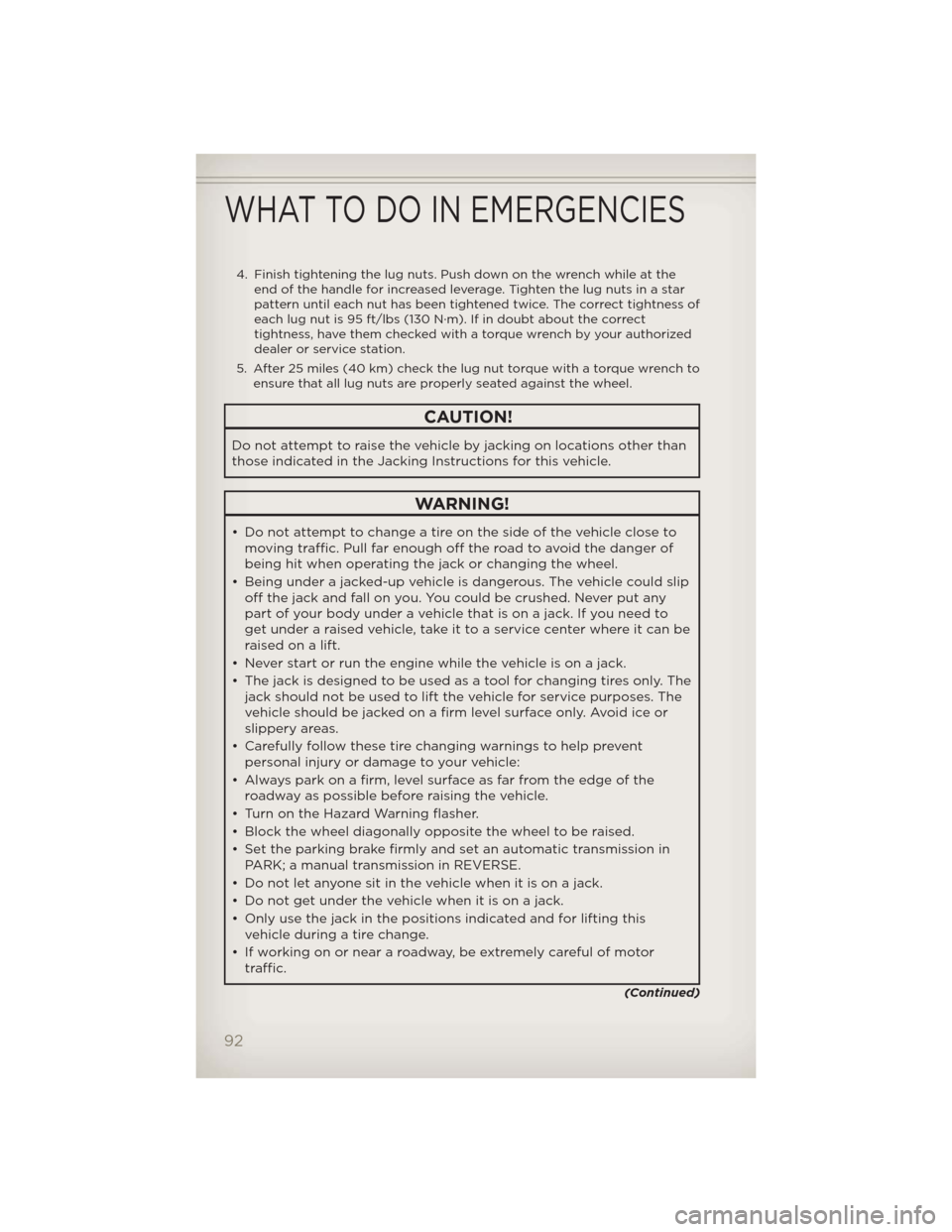
4. Finish tightening the lug nuts. Push down on the wrench while at the
end of the handle for increased leverage. Tighten the lug nuts in a star
pattern until each nut has been tightened twice. The correct tightness of
each lug nut is 95 ft/lbs (130 N·m). If in doubt about the correct
tightness, have them checked with a torque wrench by your authorized
dealer or service station.
5. After 25 miles (40 km) check the lug nut torque with a torque wrench to
ensure that all lug nuts are properly seated against the wheel.
CAUTION!
Do not attempt to raise the vehicle by jacking on locations other than
those indicated in the Jacking Instructions for this vehicle.
WARNING!
• Do not attempt to change a tire on the side of the vehicle close to
moving traffic. Pull far enough off the road to avoid the danger of
being hit when operating the jack or changing the wheel.
• Being under a jacked-up vehicle is dangerous. The vehicle could slip
off the jack and fall on you. You could be crushed. Never put any
part of your body under a vehicle that is on a jack. If you need to
get under a raised vehicle, take it to a service center where it can be
raised on a lift.
• Never start or run the engine while the vehicle is on a jack.
• The jack is designed to be used as a tool for changing tires only. The
jack should not be used to lift the vehicle for service purposes. The
vehicle should be jacked on a firm level surface only. Avoid ice or
slippery areas.
• Carefully follow these tire changing warnings to help prevent
personal injury or damage to your vehicle:
• Alwayspark on a firm, level surface as far from the edge of the
roadway as possible before raising the vehicle.
• Turn on the Hazard Warning flasher.
• Block the wheel diagonally opposite the wheel to be raised.
• Set the parking brake firmly and set an automatic transmission in
PARK; a manual transmission in REVERSE.
• Do not let anyone sit in the vehicle when it is on a jack.
• Do not get under the vehicle when it is on a jack.
• Only use the jack in the positions indicated and for lifting this
vehicle during a tire change.
• If working on or near a roadway, be extremely careful of motor
traffic.
(Continued)
WHAT TO DO IN EMERGENCIES
92
Page 95 of 124
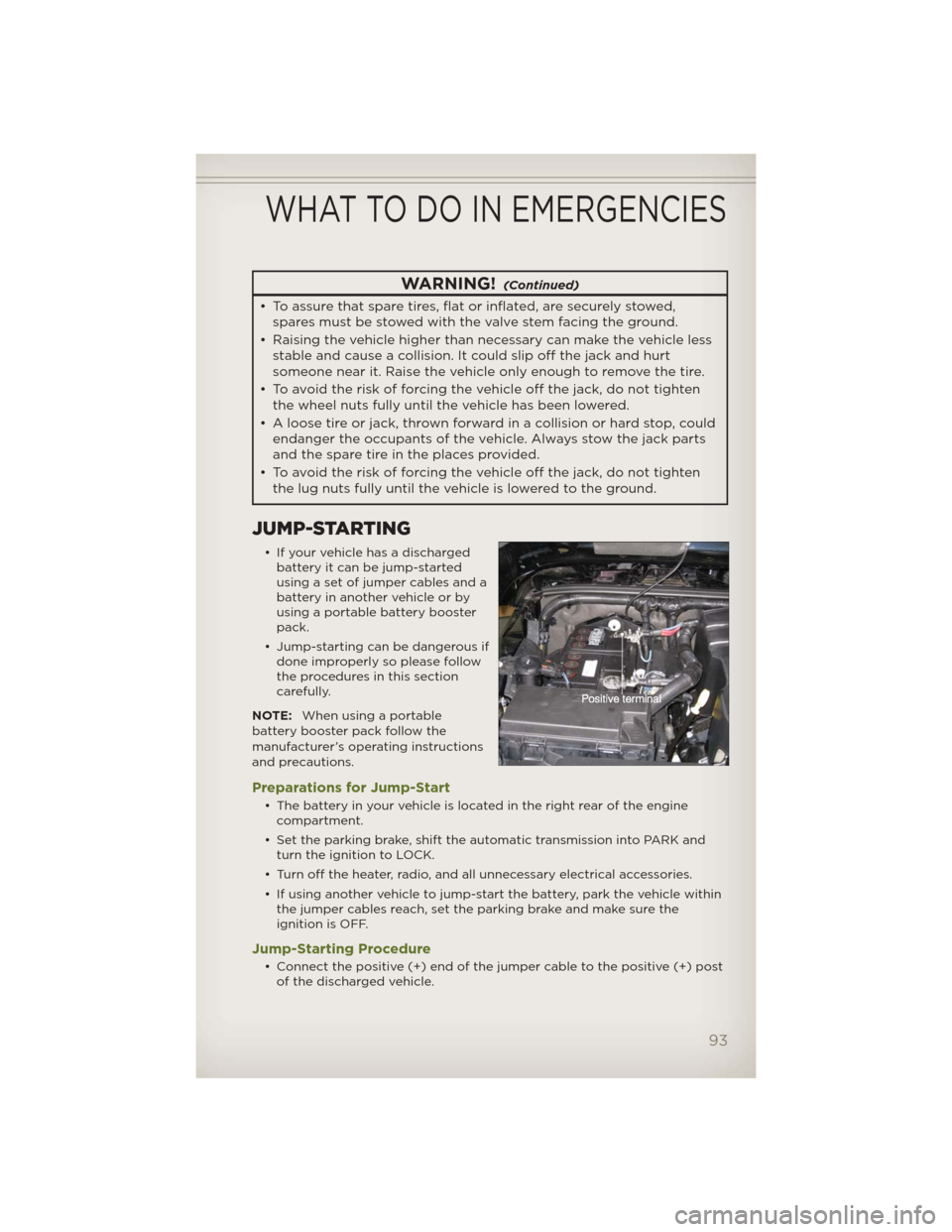
WARNING!(Continued)
• To assure that spare tires, flat or inflated, are securely stowed,
spares must be stowed with the valve stem facing the ground.
• Raising the vehicle higher than necessary can make the vehicle less
stable and cause a collision. It could slip off the jack and hurt
someone near it. Raise the vehicle only enough to remove the tire.
• To avoid the risk of forcing the vehicle off the jack, do not tighten
the wheel nuts fully until the vehicle has been lowered.
• A loose tire or jack, thrown forward in a collision or hard stop, could
endanger the occupants of the vehicle. Always stow thejack parts
and the spare tire in the places provided.
• To avoid the risk of forcing the vehicle off the jack, do not tighten
the lug nuts fully until the vehicle is lowered to the ground.
JUMP-STARTING
• If your vehicle has a discharged
battery it can be jump-started
using a set of jumper cables and a
battery in another vehicle or by
using a portable battery booster
pack.
• Jump-starting can be dangerous if
done improperly so please follow
the procedures in this section
carefully.
NOTE:When using a portable
battery booster pack follow the
manufacturer’s operating instructions
and precautions.
Preparations for Jump-Start
• The battery in your vehicle is located in the right rear of the engine
compartment.
• Set the parking brake, shift the automatic transmission into PARK and
turn the ignition to LOCK.
• Turn off the heater, radio, and all unnecessary electrical accessories.
• If using another vehicle to jump-start the battery, park the vehicle within
the jumper cables reach, set the parking brake and make sure the
ignition is OFF.
Jump-Starting Procedure
• Connect the positive (+) end of the jumper cable to the positive (+) post
of the discharged vehicle.
WHAT TO DO IN EMERGENCIES
93
Page 101 of 124
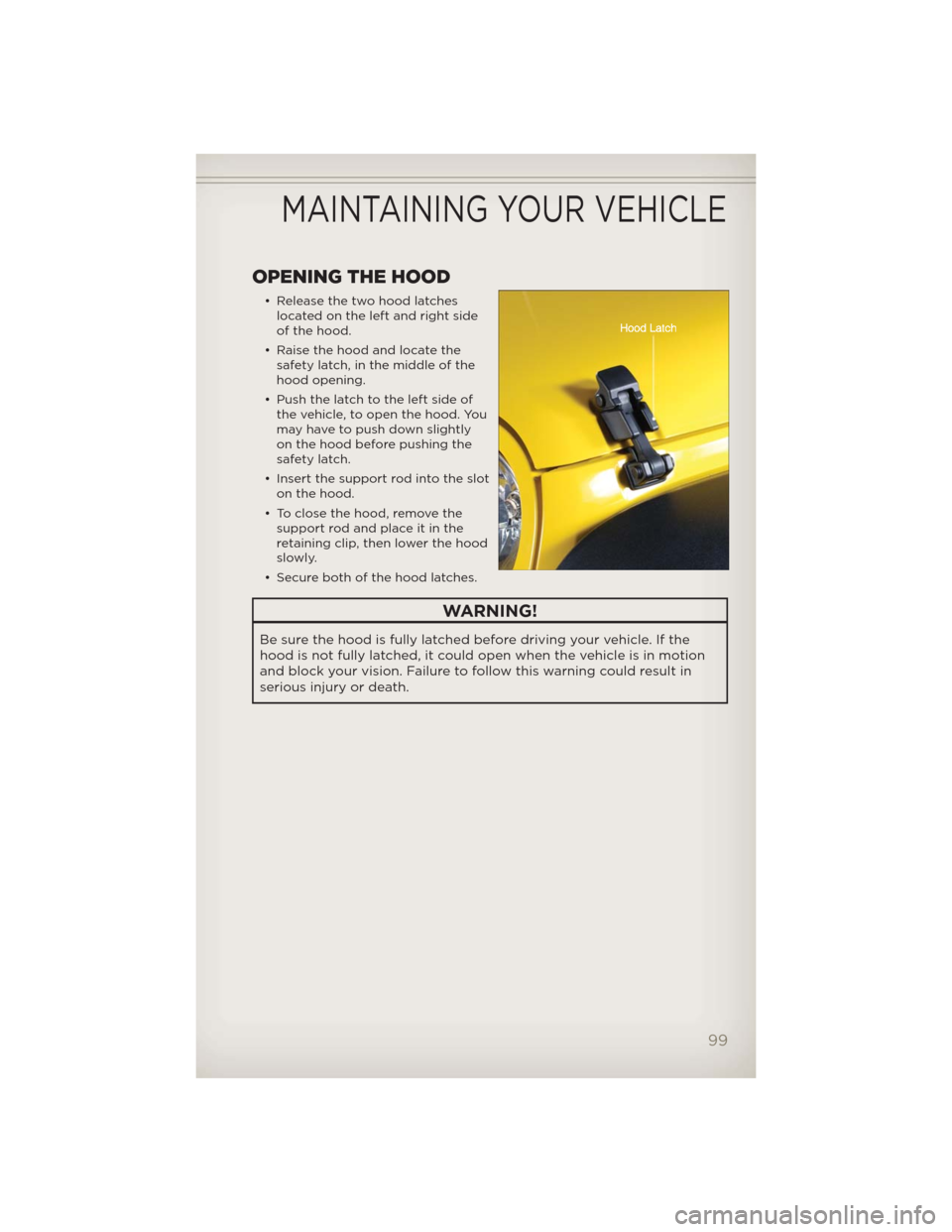
OPENING THE HOOD
• Release the two hood latches
located on the left and right side
of the hood.
• Raise the hood and locate the
safety latch, in the middle of the
hood opening.
• Push the latch to the left side of
the vehicle, to open the hood. You
mayhavetopushdownslightly
on the hood before pushing the
safety latch.
• Insert the support rod into the slot
on the hood.
• To close the hood, remove the
support rod and place it in the
retaining clip, then lower the hood
slowly.
• Secure both of the hood latches.
WARNING!
Be sure the hood is fully latched before driving your vehicle. If the
hood is not fully latched, it could open when the vehicle is in motion
and block your vision. Failure to follow this warning could result in
serious injury or death.
MAINTAINING YOUR VEHICLE
99
Page 109 of 124
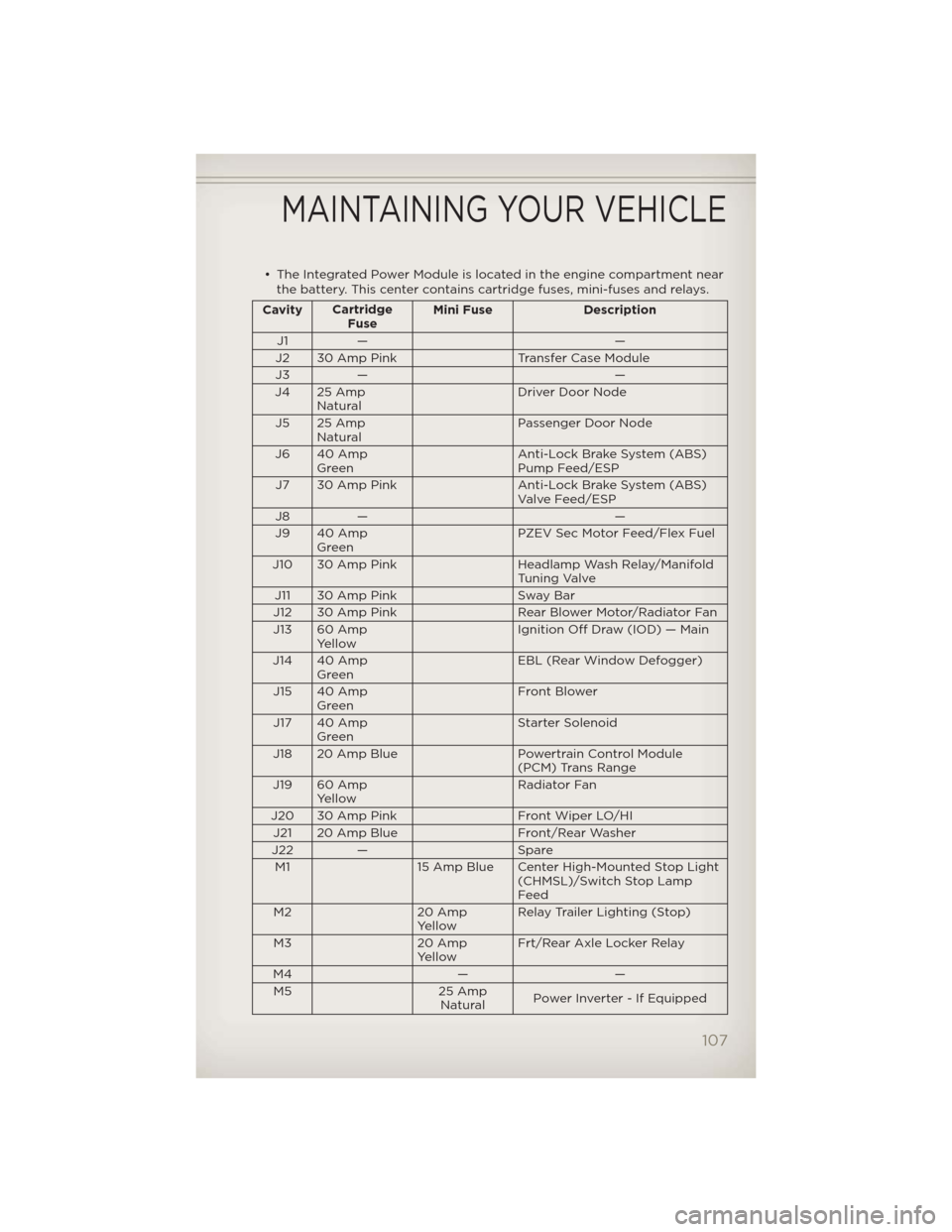
• The Integrated Power Module is located in the engine compartment near
the battery. This center contains cartridge fuses, mini-fuses and relays.
CavityCartridge
FuseMini Fuse Description
J1 — —
J2 30 Amp Pink Transfer Case Module
J3 — —
J4 25 Amp
NaturalDriver Door Node
J5 25 Amp
NaturalPassenger Door Node
J6 40 Amp
GreenAnti-Lock Brake System (ABS)
Pump Feed/ESP
J7 30 Amp Pink Anti-Lock Brake System (ABS)
Valve Feed/ESP
J8 — —
J9 40 Amp
GreenPZEV Sec Motor Feed/Flex Fuel
J10 30 Amp Pink Headlamp Wash Relay/Manifold
Tuning Valve
J11 30 Amp Pink Sway Bar
J12 30 Amp Pink Rear Blower Motor/Radiator Fan
J13 60 Amp
YellowIgnition Off Draw (IOD) — Main
J14 40 Amp
GreenEBL (Rear Window Defogger)
J15 40 Amp
GreenFront Blower
J17 40 Amp
GreenStarter Solenoid
J18 20 Amp Blue Powertrain Control Module
(PCM) Trans Range
J19 60 Amp
YellowRadiator Fan
J20 30 Amp Pink Front Wiper LO/HI
J21 20 Amp Blue Front/Rear Washer
J22 — Spare
M1 15 Amp Blue Center High-Mounted Stop Light
(CHMSL)/Switch Stop Lamp
Feed
M2 20 Amp
YellowRelay Trailer Lighting (Stop)
M3 20 Amp
YellowFrt/Rear Axle Locker Relay
M4 — —
M5 25 Amp
NaturalPower Inverter - If Equipped
MAINTAINING YOUR VEHICLE
107
Page 111 of 124
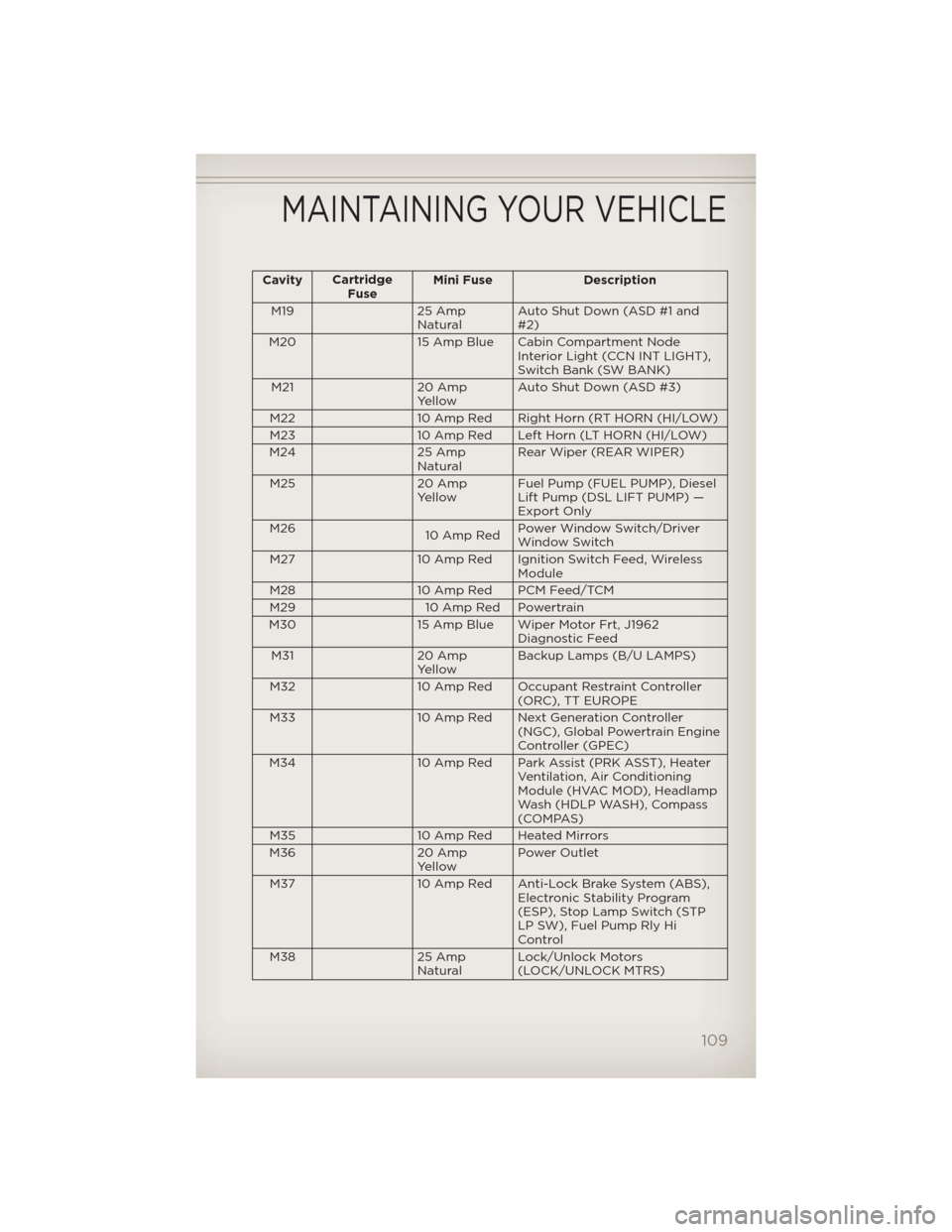
CavityCartridge
FuseMini Fuse Description
M19 25 Amp
NaturalAuto Shut Down (ASD #1 and
#2)
M20 15 Amp Blue Cabin Compartment Node
Interior Light (CCN INT LIGHT),
Switch Bank (SW BANK)
M21 20 Amp
YellowAuto Shut Down (ASD #3)
M22 10 Amp Red Right Horn (RT HORN (HI/LOW)
M23 10 Amp Red Left Horn (LT HORN (HI/LOW)
M24 25 Amp
NaturalRear Wiper (REAR WIPER)
M25 20 Amp
YellowFuel Pump (FUEL PUMP), Diesel
Lift Pump (DSL LIFT PUMP) —
Export Only
M26
10 Amp RedPower Window Switch/Driver
Window Switch
M27 10 Amp Red Ignition Switch Feed, Wireless
Module
M28 10 Amp Red PCM Feed/TCM
M29 10 Amp Red Powertrain
M30 15 Amp Blue Wiper Motor Frt, J1962
Diagnostic Feed
M31 20 Amp
YellowBackup Lamps (B/U LAMPS)
M32 10 Amp Red Occupant Restraint Controller
(ORC), TT EUROPE
M33 10 Amp Red Next Generation Controller
(NGC), Global Powertrain Engine
Controller (GPEC)
M34 10 Amp Red Park Assist (PRK ASST), Heater
Ventilation, Air Conditioning
Module (HVAC MOD), Headlamp
Wash (HDLP WASH), Compass
(COMPAS)
M35 10 Amp Red Heated Mirrors
M36 20 Amp
YellowPower Outlet
M37 10 Amp Red Anti-Lock Brake System (ABS),
Electronic Stability Program
(ESP), Stop Lamp Switch (STP
LP SW), Fuel Pump Rly Hi
Control
M38 25 Amp
NaturalLock/Unlock Motors
(LOCK/UNLOCK MTRS)
MAINTAINING YOUR VEHICLE
109
Page 117 of 124
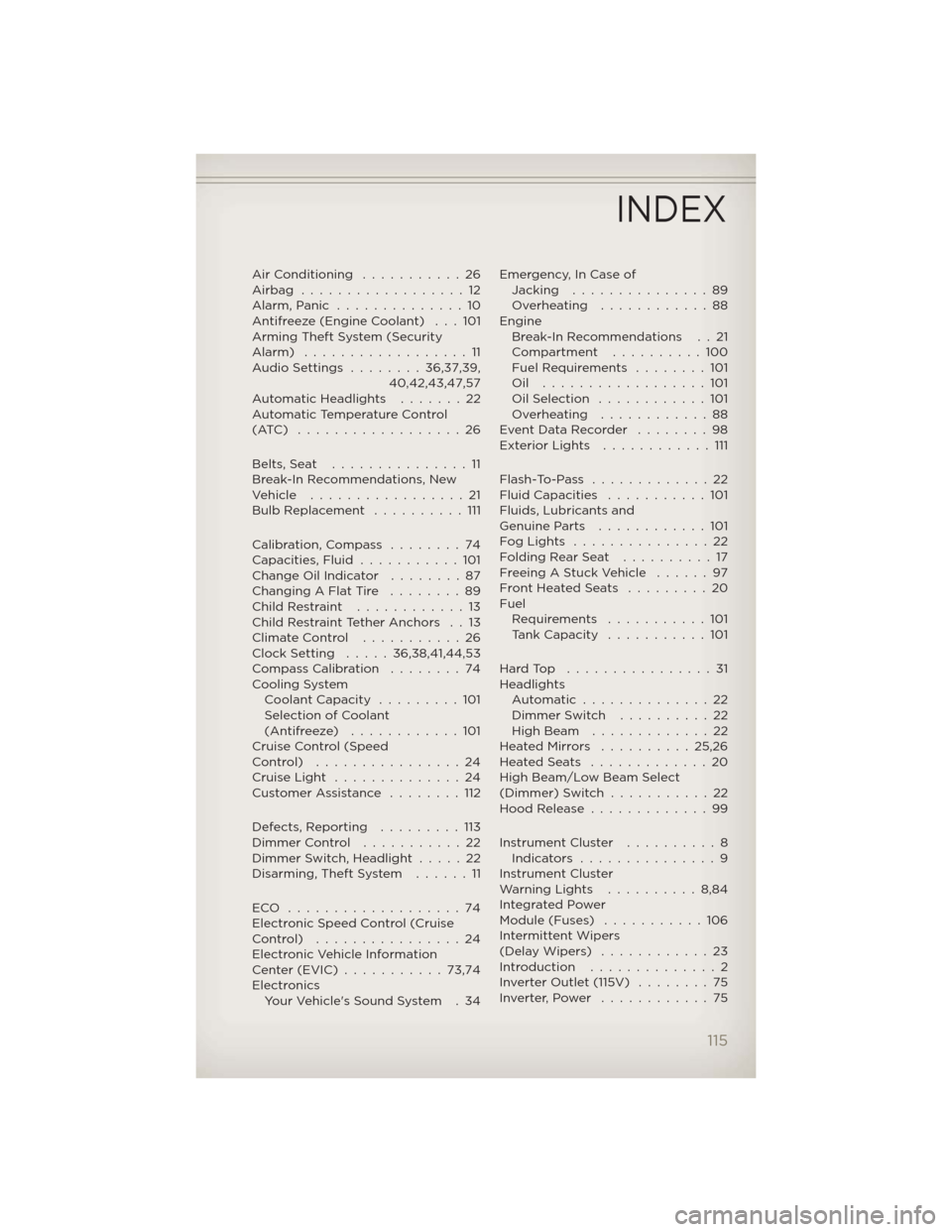
AirConditioning ...........26
Airbag ..................12
Alarm,Panic ..............10
Antifreeze (Engine Coolant) . . . 101
Arming Theft System (Security
Alarm) ..................11
AudioSettings ........36,37,39,
40,42,43,47,57
Automatic Headlights . . . . . . . 22
Automatic Temperature Control
(ATC) ..................26
Belts, Seat...............11
Break-In Recommendations, New
Vehicle .................21
Bulb Replacement..........111
Calibration, Compass . . . . . . . . 74
Capacities, Fluid...........101
Change Oil Indicator........87
Changing A Flat Tire........89
ChildRestraint ............13
Child Restraint Tether Anchors . . 13
ClimateControl ...........26
Clock Setting.....36,38,41,44,53
Compass Calibration . . . . . . . . 74
Cooling System
Coolant Capacity.........101
Selection of Coolant
(Antifreeze)............101
Cruise Control (Speed
Control) ................24
CruiseLight ..............24
Customer Assistance . . . .....112
Defects, Reporting.........113
Dimmer Control...........22
Dimmer Switch, Headlight . . . . . 22
Disarming, Theft System . . . . . . 11
ECO ...................74
Electronic Speed Control (Cruise
Control) ................24
Electronic Vehicle Information
Center(EVIC)...........73,74
Electronics
Your Vehicle's Sound System . 34Emergency, In Case of
Jacking...............89
Overheating ............88
Engine
Break-In Recommendations . . 21
Compartment . . . . . . . . . . 100
Fuel Requirements . . . .....101
Oil ..................101
OilSelection ............101
Overheating ............88
EventDataRecorder ........98
ExteriorLights ............111
Flash-To-Pass .............22
Fluid Capacities . . . . . . . . . . . 101
Fluids, Lubricants and
Genuine Parts . . . . . . . . . . . . 101
FogLights ...............22
FoldingRearSeat ..........17
FreeingAStuckVehicle ......97
Front Heated Seats . . . . . . . . . 20
Fuel
Requirements . . . . .......101
Tank Capacity . . . . . . . . . . . 101
HardTop ................31
Headlights
Automatic..............22
Dimmer Switch . . . . . . . . . . 22
High Beam . . . . . . . . . . . . . 22
HeatedMirrors ..........25,26
HeatedSeats .............20
High Beam/Low Beam Select
(Dimmer) Switch . . . . .......22
Hood Release . . . . . . . . . . . . . 99
Instrument Cluster . . . . . . . . . . 8
Indicators ...............9
Instrument Cluster
WarningLights ..........8,84
Integrated Power
Module (Fuses) . . . . . . . . . . . 106
Intermittent Wipers
(DelayWipers) ............23
Introduction . . . . . . . . . . . . . . 2
InverterOutlet(115V) ........75
Inverter,Power ............75
INDEX
115